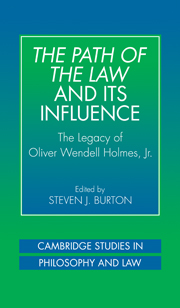Book contents
- Frontmatter
- Contents
- Acknowledgments
- List of Contributors
- The Path of the Law and Its Influence
- Introduction
- 1 Law as a Vocation: Holmes and the Lawyer's Path
- 2 The Bad Man and the Good Lawyer
- 3 Why Practice Needs Ethical Theory: Particularism, Principle, and Bad Behavior
- 4 Theories, Anti-Theories, and Norms: Comment on Nussbaum
- 5 Traversing Holmes's Path toward a Jurisprudence of Logical Form
- 6 Holmes on the Logic of the Law
- 7 Holmes versus Hart: The Bad Man in Legal Theory
- 8 The Bad Man and the Internal Point of View
- 9 Oliver Wendell Holmes, Jr., and William James: The Bad Man and the Moral Life
- 10 Emerson and Holmes: Serene Skeptics
- 11 The Path Dependence of the Law
- 12 Changing the Path of the Law
- 13 Holmes, Economics, and Classical Realism
- 14 Comment on Brian Leiter's “Holmes, Economics, and Classical Realism”
- Appendix: The Path of the Law
- Index
14 - Comment on Brian Leiter's “Holmes, Economics, and Classical Realism”
Published online by Cambridge University Press: 22 October 2009
- Frontmatter
- Contents
- Acknowledgments
- List of Contributors
- The Path of the Law and Its Influence
- Introduction
- 1 Law as a Vocation: Holmes and the Lawyer's Path
- 2 The Bad Man and the Good Lawyer
- 3 Why Practice Needs Ethical Theory: Particularism, Principle, and Bad Behavior
- 4 Theories, Anti-Theories, and Norms: Comment on Nussbaum
- 5 Traversing Holmes's Path toward a Jurisprudence of Logical Form
- 6 Holmes on the Logic of the Law
- 7 Holmes versus Hart: The Bad Man in Legal Theory
- 8 The Bad Man and the Internal Point of View
- 9 Oliver Wendell Holmes, Jr., and William James: The Bad Man and the Moral Life
- 10 Emerson and Holmes: Serene Skeptics
- 11 The Path Dependence of the Law
- 12 Changing the Path of the Law
- 13 Holmes, Economics, and Classical Realism
- 14 Comment on Brian Leiter's “Holmes, Economics, and Classical Realism”
- Appendix: The Path of the Law
- Index
Summary
In “Holmes, Economics, and Classical Realism” (Chapter 13 of this volume), Brian Leiter takes recent comparisons between Holmes and Nietzsche as an occasion to excavate the remarkably well-preserved remains of a view he calls classical realism. That view asserts three formal theses: (1) the naturalistic thesis, which claims that there exist certain “incorrigible … facts about human beings and human nature”; (2) the quietistic thesis, which holds that “any normative theorizing which fails to respect the limits imposed by these facts about human nature is idle and pointless; it is better to ‘keep quiet’ about normative matters than to theorize in ways that make no difference to practice”; and (3) the realistic thesis, which claims that the “aim of theory construction is to depict the incorrigible facts as they really are, without illusion or romance; theory aims for descriptive and explanatory accuracy rather than normative edification or rationalization.” The substantive theory of classical realism is that (1) human beings are essentially selfish, and (2) that human beings are consistently irrational, “simple-minded, easily fooled, and susceptible to being controlled and used.” A good deal of Leiter's essay is devoted to vindicating the claim that classical realism is not a figment of his imagination, but instead enjoys a rather distinguished intellectual history, traceable in its general form from Thucydides through Nietzsche and Marx and finding its jurisprudential expression in the work of Jerome Frank, Karl Llewellyn, and, not incidentally, Oliver Wendell Holmes, Jr. Leiter's analysis is designed for the Holmes and Nietzsche scholar, carefully marshaling the resources necessary to uncover the essence of classical realism in the work of both figures and forcefully arguing against the alternative reading of their common ground offered by Richard Posner and David Luban.
- Type
- Chapter
- Information
- The Path of the Law and its InfluenceThe Legacy of Oliver Wendell Holmes, Jr, pp. 326 - 332Publisher: Cambridge University PressPrint publication year: 2000
- 1
- Cited by

